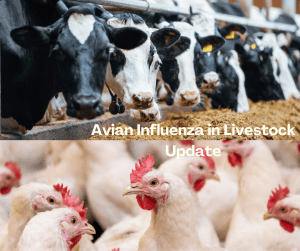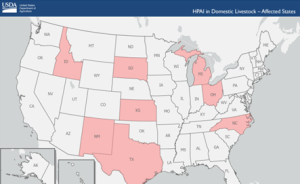 Our knowledge of avian influenza in dairy cattle is an evolving situation. Novel diseases are similar to new technology; we learn how to better manage them as we spend more time interacting with them and testing how they function under different circumstances. Below are a few updates regarding our knowledge of this virus in cattle. Please refer to our 4/8 blog post for a full list of reputable resources to help you stay up to date and find our video for Spanish speaking employees here.
Our knowledge of avian influenza in dairy cattle is an evolving situation. Novel diseases are similar to new technology; we learn how to better manage them as we spend more time interacting with them and testing how they function under different circumstances. Below are a few updates regarding our knowledge of this virus in cattle. Please refer to our 4/8 blog post for a full list of reputable resources to help you stay up to date and find our video for Spanish speaking employees here.
- Why does this blog say “Bovine Influenza A Virus” not HPAI? The American Association of Bovine Practitioners (AABP), is encouraging the industry to refer to the virus as BIAV because, “the virus isolated from affected animals in herds matching the clinical syndrome has been identified as avian influenza virus Type A H5N1. This virus causes Highly Pathogenic Avian Influenza in birds, however the disease syndrome in cattle does not cause high morbidity and mortality as it does in birds.”
- Here are the states with confirmed cases of HPAI in livestock as of 4/24 3:30pm:

- As a result of continued spread of the virus to cattle herds as well as poultry flocks, New York Ag and Markets has issued the following temporary import requirements for dairy cattle to New York State. Note: there have been no detected cases of HPAI in dairy cattle or goats in New York to date.
- Importation of dairy cattle from a premises with a confirmed case of HPAI or a premises under investigation as a suspect premises is prohibited;
- Dairy cattle imported from affected states must be accompanied by a Certificate of Veterinary Inspection (CVI) issued within 10 days prior to entry into the state; and
- CVIs issued for dairy cattle from affected states must include the statement: “All animals identified on the Certificate of Veterinary (CVI) have been examined and do not originate from a premises with a confirmed detection of Highly Pathogenic Avian Influenza, or that is currently under investigation as a suspect premises.”


At this point we do not know as beef cattle have not been tested or found with clinical signs. The USDA APHIS states: So far there have been no detections in commercial beef herds. USDA is confident that the meat supply is safe. USDA Food Safety and Inspection Service (FSIS) veterinarians are present at all federal livestock slaughter facilities to inspect animals prior to slaughter and ensure sick animals are prevented from entering the food supply. As always, we encourage consumers to properly handle raw meats and to cook to a safe internal temperature. Cooking to a safe internal temperature kills bacteria and viruses in meat. We will continue to monitor the impact of H5N1 on supply and prices, while working with state and industry partners to ensure our nation’s food supply remains safe.
Does this affect beef cattle or just dairy?